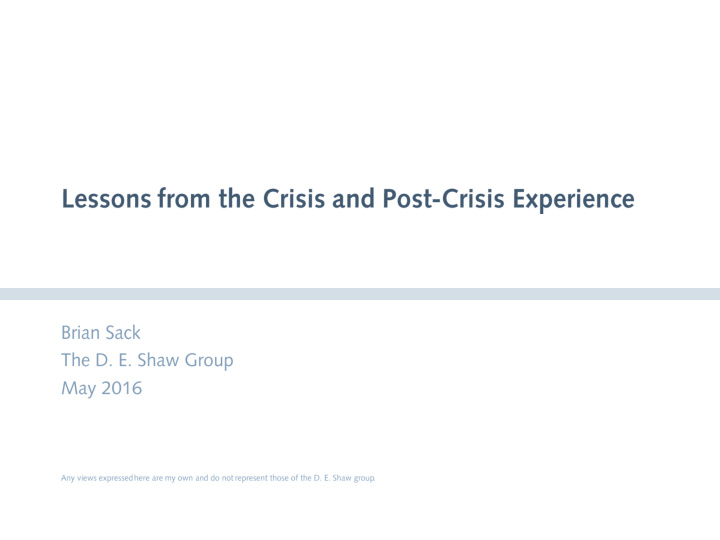



1. The Fed needs to have an effective set of standing tools for providing liquidity. The Fed showed remarkable innovation during the crisis But that success came mostly from introducing new facilities rather than from standing facilities And the Fed faced several constraints that might have slowed its response Framework should be able to more effectively provide liquidity to the banking sector through standing facilities Also important to consider whether facilities should include a wider set of counterparties
Source: Fleming and Klagge (2011), “Income Effects of Federal Reserve Liquidity Facilities,” Current Issues , Volume 17-1, Federal Reserve Bank of New York.
2. The Fed needs to have the capacity to do large-scale asset purchases. Asset purchase programs can be an effective policy instrument Central banks need to retain the option to do asset purchases because of the lower bound on short-term interest rates Operational capacity to do LSAPs should be maintained Framework should allow a smooth transition to an expanded balance sheet
Source: Domestic Open Market Operations During 2015 , Federal Reserve Bank of New York.
3. The Fed should consider a larger balance sheet in steady state, with the policy rate managed in a floor system. Key aspect of framework debate will be whether to operate in floor or corridor system Possible to have large steady-state balance sheet and rely on IOER and RRP to control the policy rate There are some advantages to maintaining large balance sheet (more liquidity in the financial system)
4. The composition of the Fed’s steady state portfolio of Treasuries should be optimized. Before the crisis, the Fed’s balance sheet holdings were governed by Treasury issuance patterns Fed should optimize the composition of its Treasury holdings for policy- oriented objectives Argument for holding bills: provides flexibility to drain quickly if needed
Source: Domestic Open Market Operations During 2015 , Federal Reserve Bank of New York.
5. The Fed can effectively control the policy rate even with a large balance sheet. Control of short-term interest rates is most important aspect of framework; Fed needs to have an effective floor Fed has demonstrated impressive control of short-term interest rates Allows it to make decisions about balance sheet without compromising control of monetary policy IOER alone does not provide a hard floor, but the combination of IOER and RRP seems to be working well
Median Expectations from FRBNY Primary Dealer Survey, 12/7/2015 Immediately 1 Year After Liftoff After Liftoff Fed IOER Rate 0.50% 1.25% Effective Fed 0.34% 1.11% Funds Rate Treasury Tri-Party 0.30% 1.06% O/N Repo Rate Fed O/N RRP Rate 0.25% 1.00% Source: Federal Reserve Bank of New York. Source: Bloomberg, BNY Mellon.
Median Expectations from FRBNY Primary Dealer Survey, 12/7/2015 Immediately 1 Year After Liftoff After Liftoff O/N RRP Demand $300 bn $350 bn O/N RRP Cap $600 bn $450 bn Source: Federal Reserve Bank of New York. Source: Federal Reserve Bank of New York.
6. RRPs should be a regular part of the Fed’s policy framework. Hard to understand the desire to phase out RRPs as quickly as possible Concerns about the Fed’s footprint in markets were not fully explained Best framework for ensuring effective control of short rates probably involves combination of RRP and IOER Current configuration of administered rates has some shortcomings
7. The Fed should consider an alternative target variable. The federal funds market currently has a limited amount of activity If want an unsecured rate, the OBFR likely dominates the federal funds rate Fed could also consider a secured rate or its administered rates as the target Fed likely has concern about a broader configuration of money market rates beyond its single target variable
8. The Fed should clarify if negative rates are part of the policy toolkit. Prospect of negative interest rates is already affecting market prices Fed could communicate whether negative rates are part of the toolkit and indicate the threshold to which they would be willing to adjust rates Knowing the Fed’s views on negative rates would help markets more efficiently price policy prospects
* Based on options on eurodollar futures contracts. Source: Bloomberg.
Recommend
More recommend